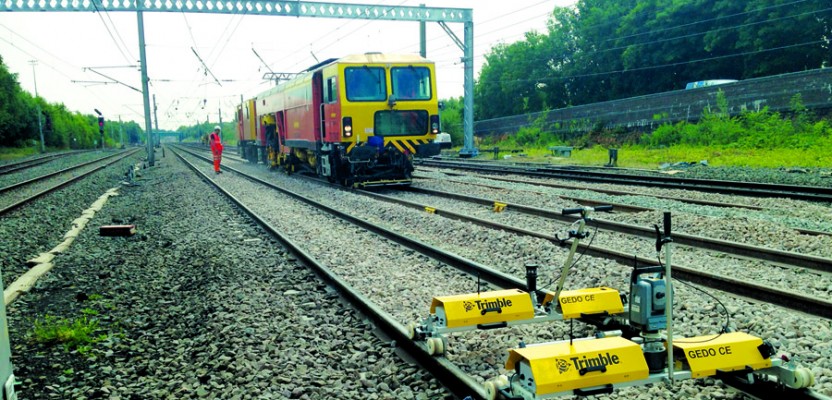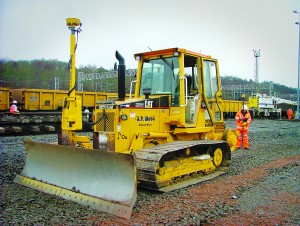A highly traveled section of the UK’s West Coast Mainline rail corridor (between Warrington and Preston) required the renewal of three miles (five km) of track among four major junctions. In an intensive, nine-day continuous spell, the innovation team at Network Rail completed the work almost 16 months earlier than proposed—and avoided disrupting rail travel.
Network Rail, the organization that runs, maintains, and develops Britain’s rail systems, achieved this considerable feat because they graded the sites with machine control, reduced tamping runs using real-time data, shared all data across work processes, and monitored and recorded track movement data via video.
What’s more, the work set a new standard in the UK for switch and crossing renewal: at the time of handback, or return to service, trains could operate at 80 mile/hr (130 km/hr), a 60% increase over the normal 50 mph (80 kph) handback speed.
Machine Control
As a long-term user of machine control and being familiar with its ruggedness and suitability for rail work, track engineer Colin McAteer applied a single-mast Trimble GCS900 3D grade control solution on site dozers—a relatively new way to work in switch and crossing and line renewal. McAteer and his team were confident that the single-mast system would be sufficient for the dozer operators to dig the formation and place ballast at +/-0.05 ft (15mm) precision using GNSS or at +/-0.02 ft (5mm) with a universal total station. The switch from antenna to prism could be made in just 10 minutes. The single-mast systems were run off a single GNSS base station, which kept costs down.
“The quality of the GNSS positioning meant that we could position the rail panels within 15 millimeters [0.05 ft] of final position and, in fact, only needed to tamp once, saving us much needed time,” McAteer stated.
Real-time Data
The GEDO Vorsys pre-measurement system uses two track-mounted trolleys working together, one with a Trimble S-Series total station and the other with the prism and control unit. The trolley sensors measure the gauge (distance between the running edge of the rails) and the cant (superelevation of the track) and continually transfer the data wirelessly to a Trimble TSC3 Controller.
Shared Data
The GEDO Vorsys field software running on the controller combines the data from the sensors with 3D positions from the total station to enable real-time data to be displayed live in the field. This solution provides the high level of accuracy required by the railway industry with operational speed and flexibility.
Measurements are made using georeferenced control points positioned along the track. Since the full track design geometry is stored in the controller, the field software can calculate and display the lift and slew values to final design, the cant and gauge information, and all the significant points where the track geometry changes—a substantial time and accuracy advantage over manual recording.
The grade-control system “doubled our sampling rate and halved our survey time,” McAteer explained. “We could sample every 5 meters [16 ft] compared to every 10 meters [33 ft] with pegs. We were therefore easily surveying 500- to 600-meter [1600-1900-ft] stretches in just 40 minutes rather than the half day-plus it would have taken with traditional methods.”
Additionally, the speed raiser report, which included horizontal and vertical tolerances along with twist and gauge parameters, provided an extra level of confidence that allowed the handback engineer to open the track at 80 mph (130 kph).
“The ballast and formation data is prepared in Trimble Business Center software and is the root data that goes into Vorsys,” McAteer explained. “TBC also allowed us to visualize the design beforehand with the drive-through function, which allowed us to spot issues on the DTM.”
This combination of interchangeable technologies proved to be ideal on Network Rail’s corridor job. “Our engineers are all working from the same design data and using the same software interface whether they are carrying out a grade check or an as-built survey,” McAteer said. “This brings familiarity, which means the team can skip between tasks seamlessly. There is no additional training required, and that cuts site downtime and improves the quality of work.”
Video Monitoring
The precise efforts and rail work process advancements were then monitored to check for any track displacement that may lead to voiding. This is usually done by placing void meters under the track, but instead, engineers used a non-contact precision measurement video monitoring system, which accurately measured dynamic deflection at a distance and under train loading, all with sub-millimeter accuracy. A computer, software, and one or more high-resolution digital video cameras recorded data to be stored for later analysis or analyzed live for real-time monitoring.
At two of the junctions, workers identified targets, set into the system vertical displacement parameters to be recorded, and began manually recording a few seconds before the train passed the targets to give a “datum” status for the track. Video ran for a few seconds after the train had passed to ensure the track had returned to its starting position.
For each video, a text file was created showing the data captured for each of the measured parameters at each of the target locations. The system captured the magnitude of any movements as a number of pixels, which were then converted to millimeters.
With this data, “we now had a clear indication that the track wasn’t deteriorating under load, which is of paramount importance in our decision to go with an 80-mph opening and achieve full operating speeds of 110 mph [180 kph] in just seven days,” McAteer said. “We pushed the barriers, and, thanks to a combination of great systems, great people, and great teamwork, we delivered the UK’s first-ever 80-mph handback.”


